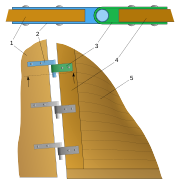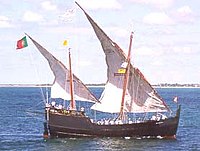A Brief Study of Medieval Ships
Medieval ships
http://en.wikipedia.org/wiki/Medieval_shipFrom Wikipedia, the free encyclopedia
| Please help improve this article or section by expanding it. Further information might be found on the talk page. (February 2007) |

Ships were greatly used in the Middle Ages. The use of these gigantic ships were mainly for trading purposes. Traveling by ships was also much safer than traveling by land. A disadvantage for sailors was that the early maps weren't very accurate. Thus, if one got lost, there was very little chance that one would return home safely or alive.
People in the Middle Ages often traded with slaves, carriages, and working animals such as horses. This was why the ships were built oversized, in order to accommodate their products.
Contents[hide] |
[edit] Early Middle Ages
[edit] Longship
The longship was a type of ship that was developed over a period of centuries and perfected by its most famous user, the Vikings, in approximately the 9th century. The ships were clinker-built, utilizing overlapping wooden strakes.
[edit] Knarr
The knaar, a relative of the longship, was a type of cargo vessel. It differed from the longship in that it was larger and relied solely on its square rigged sail for propulsion.
[edit] High Middle Ages
[edit] Cog
The cog was a design which is believed to have evolved from (or at least been influenced by) the longship, and was in wide use by the 12th century. It too used the clinker method of construction. It was most famous for its use by the Hanseatic League
The first mention of a cog is from 948 AD in Muiden near Amsterdam. These early cogs probably used a steering oar (side rudder, quarter rudder). There is no evidence of a stern rudder in northern Europe until about 1240. It is hard to tell exactly what cogs looked like. The best preserved is the Bremen cog, where the hull is preserved but not the rig. Other than that, we have to rely on contemporary images.
These images show that the cog was a wide and spacious transport ship. Early cogs had open hulls and could be rowed short distances. During the 13th century they became larger and received a deck, as well as a raised platform in the bow and stern. These are some features which are common for all cogs: one yard-sail; clinker outer planking at the sides of the hull; straight stem and sternpost, opposed to the rounded Viking stem; strong cross-beams, usually protruded through the ship's sides, to hold the sides together. Source: Nordic Underwater Archeology; http://www.abc.se/~m10354/mar/cog.htm
[edit] Late Middle Ages

[edit] Caravel
The caravel was a ship invented in Moorish Spain and used in the Mediterranean from the 13th century. Unlike the longship and cog, it used a carvel method of construction. It could be either square rigged (Caravela Redonda) or lateen rigged (Caravela Latina). The most famous examples of caravels were the Niña and the Pinta
[edit] Carrack
The carrack was another type of ship invented in the Mediterranean in the 15th century. It was a larger vessel than the caravel. Columbus’s ship, the Santa María was a famous example of a carrack.
[edit] See also
- Horse transports in the Middle Ages (an article about horse transport by ship in the Middle Ages)
- Medieval European maritime culture
[edit] Further reading
- Hutchinson, Gillian (1994). Medieval Ships and Shipping. London: Leicester University Press, ISBN 0-7185-1413-0
[edit] External links
- Hanseatic League ship of 1470 High resolution photos of a model







Comments